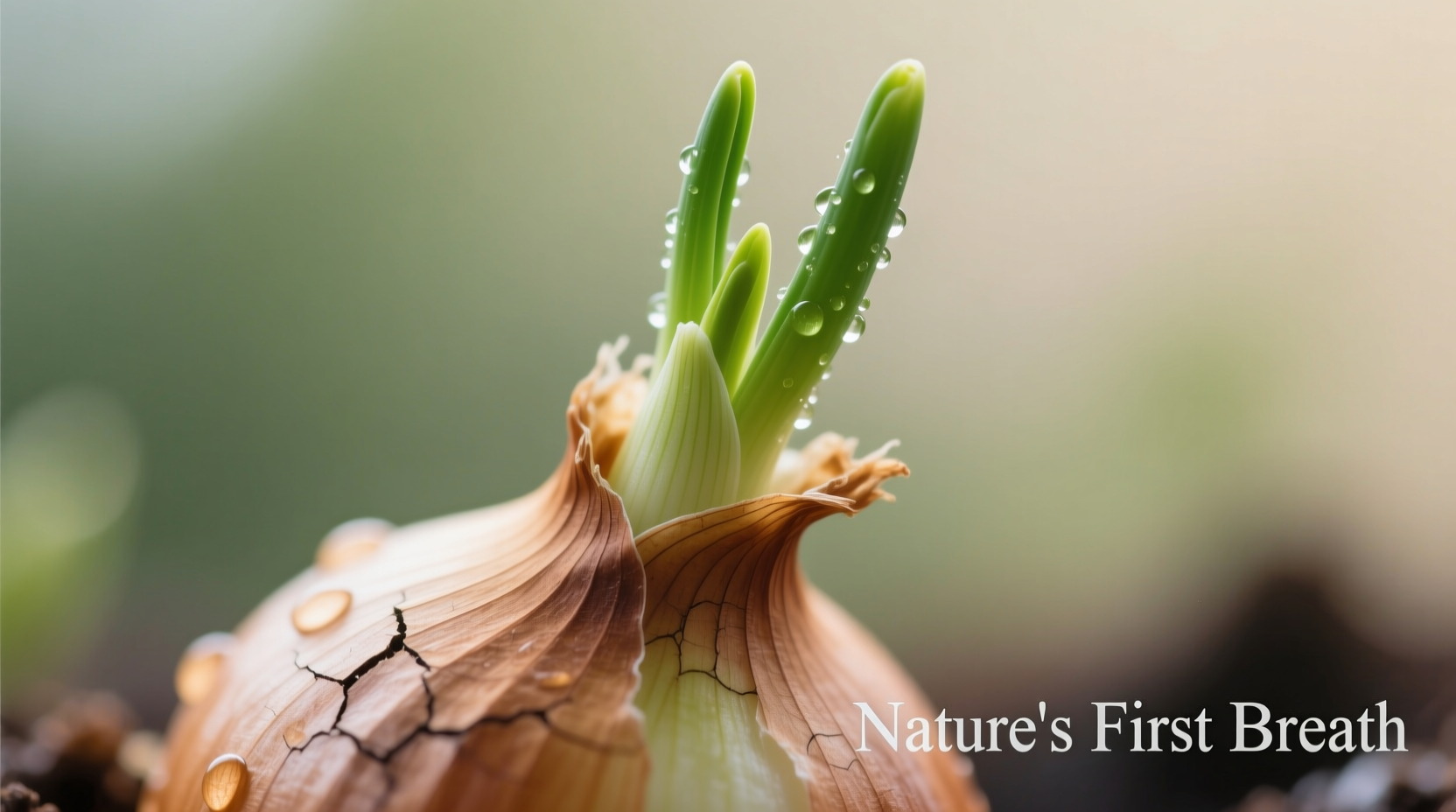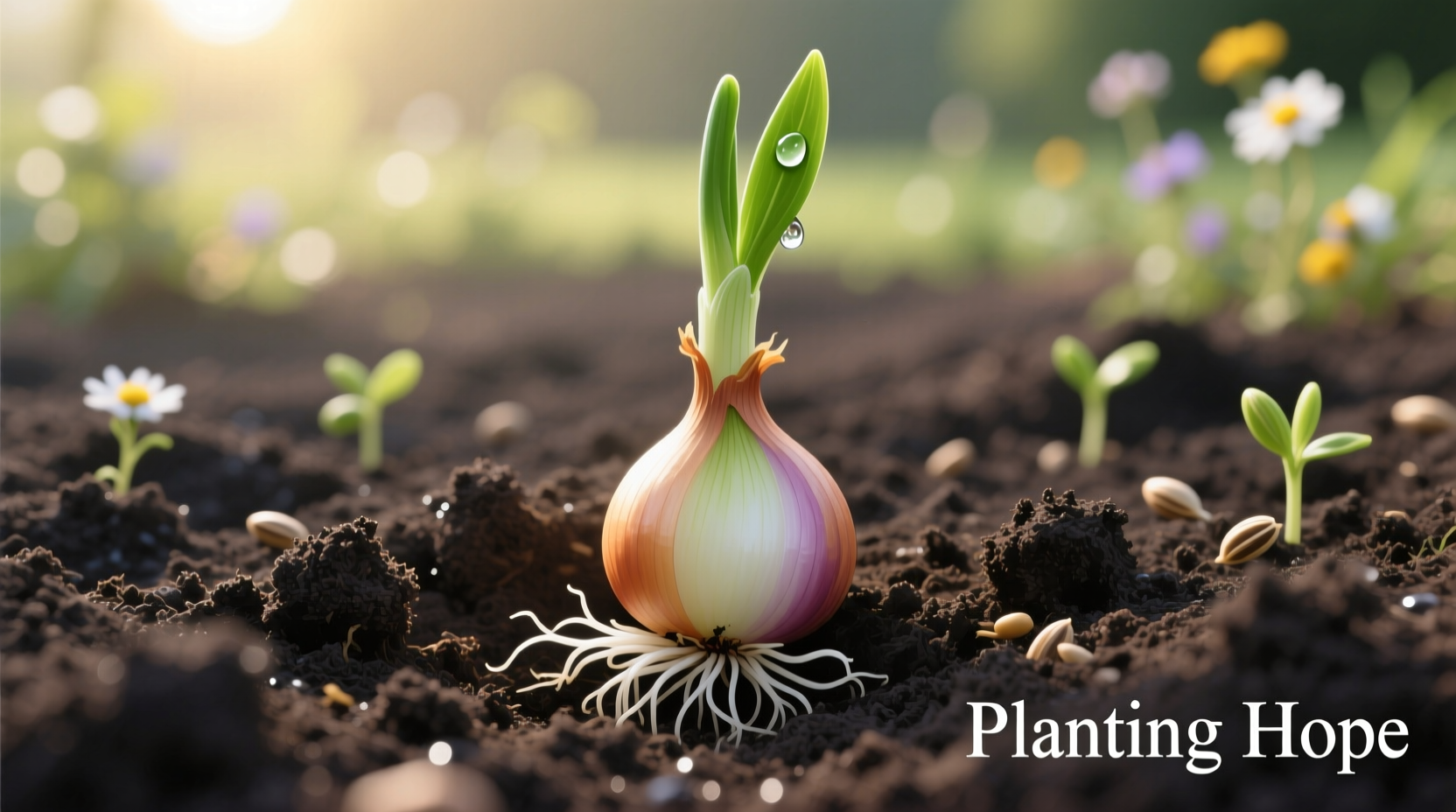Yes, you can successfully plant a sprouted onion and grow a new crop. By following proper planting techniques, you'll transform that accidentally sprouted pantry onion into fresh green shoots within days and potentially harvest new bulbs in 60-90 days. This guide reveals exactly how to prepare, plant, and care for sprouted onions to maximize your gardening success while reducing food waste.
Why Your Onion Sprouted (And Why That's Good News)
That green shoot emerging from your stored onion isn't a sign of spoilage—it's nature's signal that your onion is ready to grow. Onions sprout when exposed to warm temperatures and humidity, activating their natural growth cycle. According to the USDA Agricultural Research Service, alliums like onions enter dormancy after harvest, but when conditions improve, they resume growth to reproduce. This biological process makes sprouted onions perfect candidates for planting rather than discarding.

Step-by-Step: Preparing Your Sprouted Onion for Planting
Not all sprouted onions make equally good planting candidates. Follow these preparation steps for best results:
Selecting the Right Sprouted Onion
Choose onions with firm bulbs and healthy green shoots at least 2-3 inches long. Avoid those with soft spots, mold, or excessive shriveling. The University of California Cooperative Extension confirms that firmness indicates sufficient energy reserves for successful regrowth.
Separating the Sprout from the Bulb
Unlike planting whole bulbs, sprouted onions benefit from separation:
- Carefully cut the top third of the onion, including the green sprout
- Peel away outer layers to expose the central shoot cluster
- Leave about 1 inch of bulb attached to the base of the sprouts
| Planting Method | Time to Harvest | Success Rate | Best For |
|---|---|---|---|
| Sprouted onion tops | 60-90 days | 85% | Quick green onions, limited space |
| Whole sprouted bulb | 90-120 days | 65% | Full-sized bulbs |
| Onion sets | 75-100 days | 90% | Reliable bulb production |
This comparison from Cornell University's gardening research shows why separating sprouts often yields better results than planting whole bulbs.
Planting Your Sprouted Onion: The Right Way
Proper planting technique determines whether your sprouted onion thrives or fails. Follow these science-backed steps:
Soil Preparation Essentials
Onions require loose, well-draining soil with pH between 6.0-7.5. The USDA Natural Resources Conservation Service recommends amending heavy soils with 3-4 inches of compost worked to 8-10 inch depth. Avoid nitrogen-rich fertilizers initially, which promote leaf growth at the expense of bulb development.
Planting Depth and Spacing
Plant your separated sprout cluster with the white base just below soil surface:
- Space plants 4-6 inches apart in rows 12-18 inches apart
- Cover roots completely but keep green shoots exposed
- Water immediately after planting with 1 inch of water
Growth Timeline: What to Expect Week by Week
Understanding your onion's development stages helps you provide appropriate care:
- Days 1-7: Roots establish while green shoots continue growing upward
- Weeks 2-4: Visible leaf growth accelerates; first thinning possible for green onions
- Weeks 5-8: Bulb formation begins as days lengthen (critical watering phase)
- Weeks 9-12: Bulbs swell; reduce watering to prepare for harvest
This timeline from the Royal Horticultural Society reflects typical growth patterns for sprouted onions in temperate climates. Note that planting season significantly affects growth speed—spring-planted onions mature faster than fall plantings.
Common Mistakes That Doom Sprouted Onion Plants
Avoid these frequent errors that prevent successful growth:
Overwatering During Early Growth
While onions need consistent moisture, excess water during establishment promotes rot. The University of Minnesota Extension advises watering only when top inch of soil feels dry during the first three weeks.
Planting Too Deep
Buried green shoots struggle to reach sunlight. Keep the white bulb base covered but ensure green growth points remain above soil level for optimal photosynthesis.
Ignoring Day Length Requirements
Onions are day-length sensitive. Short-day varieties (best for southern regions) form bulbs when days reach 10-12 hours, while long-day types (northern regions) require 14-16 hours. Planting mismatched varieties creates small or failed bulbs.
Harvesting Your Homegrown Onions
Knowing when to harvest determines storage success:
- Green onions: Harvest when shoots reach 6-8 inches tall (3-4 weeks)
- Bulbing onions: Wait until tops yellow and fall over naturally (60-90 days)
- Cure bulbs for 7-10 days in warm, dry location before storage
Properly cured onions from sprouted plantings typically store 2-3 months—shorter than commercial varieties but still valuable for home use. The National Onion Association confirms that homegrown onions often have superior flavor despite smaller size.
Troubleshooting Poor Growth
If your sprouted onion isn't thriving, check these common issues:
Yellowing Leaves
Could indicate nitrogen deficiency. Apply balanced fertilizer (10-10-10) at half-strength. The Clemson Cooperative Extension notes that onions require consistent nutrition during bulb formation.
Stunted Growth
Often caused by overcrowding or poor soil. Thin plants to minimum 4-inch spacing and ensure soil pH remains between 6.0-7.5 through regular testing.
Soft Bulbs at Harvest
Results from inconsistent watering during bulbing phase. Maintain even moisture (1 inch per week) during weeks 5-8 when bulbs form.
When Sprouted Onion Planting Won't Work
Understand these limitations to set realistic expectations:
- Onions treated with sprout inhibitors (common in commercial storage) rarely grow well
- Extremely dry or shriveled bulbs lack energy reserves for regrowth
- Tropical climates often prevent proper bulb formation due to insufficient cool period
The Texas A&M AgriLife Extension emphasizes that while most sprouted onions can be planted, success depends on the onion's original variety and storage conditions. Sweet onions typically perform better than storage varieties when planted from sprouts.











 浙公网安备
33010002000092号
浙公网安备
33010002000092号 浙B2-20120091-4
浙B2-20120091-4